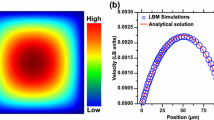Abstract
Based upon a three-dimensional computer-tomography of hardened cement paste, a finite-element mesh at micrometer length scale is introduced. Effective material properties are obtained through numerical homogenization techniques using representative volume elements. Statistical tests, two- and three-dimensional computations and a comparison with experimental data are shown. For the hydration products of hardened cement paste a visco-plastic constitutive equation of Perzyna type including isotropic damage is introduced. The inelastic material parameters are identified solving an optimization problem through a combination of a stochastic genetic algorithm and the deterministic Levenberg-Marquardt method. The time-consuming evaluations of the corresponding objective function are distributed within a network environment automatically.
Similar content being viewed by others
References
Acker P (2001) Micromechanical analysis of creep and shrinkage mechanisms. In: Creep, Shrinkage and Durability Mechanics of Concrete and other Quasi-Brittle materials: Proceedings of the sixth international conference 1:15–25
André M (2001) Thermomechanisches Verhalten von Gummimaterialien während der Vulkanisation(thermo-mechanically coupled behavior of rubber materials during vulcanization). PhD thesis, University of Hannover
Bernard O, Ulm FJ and Lemarchand E (2003). A multiscale micromechanics-hydration model for the early-age elastic properties of cement-based materials. Cement Concrete Res 33: 1293–1309
Constantinides G and Ulm FJ (2004). The effect of two types of csh on the elasticity of cement-based materials: Results from nanoindentation and micromechanical modeling. Cement Concrete Res 34: 67–80
Copuroglu O, Schlangen E, Zhu W (2006) Effect of carbonation on the micro-mechanical properties and frost salt scaling of cement pastes: experimental and modelling aspects. In: Proceedings of the second International Symposium on Advances in Concrete through Science and Engineering, Quebec City, Canada, 2006
Döbert C (2001) Meso-Makromechanische Modellierung von Faserverbundwerkstoffen mit Schädigung(meso-macro mechanically modelling of fiber-composites including damage). PhD thesis, University of Hannover
Geiger C and Kanzow C (1999). Numerische Verfahren zur Lösung unrestringierter Optimierungsaufgaben (Numerical schemes for solving unconstraint optimization problems). Springer, Berlin
Grassl P and Jirásek M (2006). Damage-plastic model for concrete failure. Int J Solids Struct 43: 7166–7196
Gross D and Seelig T (2001). Bruchmechanik (Fracture mechanics). Springer, Berlin
Koster M, Hannawald J and Brameshuber W (2006). Simulation of water permeability and water vapor diffusion through hardened cement paste. Comput Mech 37(2): 163–172
Lemaitre J (1996). A course on damage mechanics. Springer, Berlin
Lenkenhoff R (1998) Mikroskopischer Nachweis der Rißentwicklung im Betongefüge (micro-scopic detection of crack evolution in concrete). PhD thesis, Ruhr-University of Bochum
Mahnken R and Stein E (1994). The identification of parameters for visco-plastic models via finite-element methods and gradient methods. Model Simul Mater Sci Eng 2(3a): 597–616
Mehta PK and Monteiro PJM (2006). Concrete-microstructure, properties and materials. McGraw-Hill, New York
Pollakowski M (2004) Grundkurs Socketprogrammierung mit C unter Linux (Basic cource of socket programming in C with Linux). Vieweg Verlag
Powers TC (1962) Physical properties of cement paste. In: Proceedings of the fourth international symposium on the Chemistry of Cement; Paper V-1: Physical properties of cement paste 2(43):577–613
Powers TC and Brownyard TL (1948). Studies of the physical properties of hardened portland cement paste. Research Laboratories of the Portland Cement Association Bulletin 22: 101–992
Simo JC and Hughes TJR (1997). Computational inelasticity. Springer, Berlin
Thielecke F (1997) Parameteridentifizierung von Simulationsmodellen für das viskoplastische Verhalten von Metallen-Theorie, Numerik, Anwendung-(parameter identification of simulations for the visco-plastic behavior of metals -theory, numerics, application-). PhD thesis, Technical University of Braunschweig
Torquato S (2002). Random heterogeneous materials. Springer, Berlin
Webpage (http://fire.nist.gov/bfrlpubs/build00/art060.html) National institute of standards and technology
Webpage (http://www.ce.berkeley.edu/~rlt/) Homepage r.l. taylor
Wedemeier T (1990) Beiträge zur Theorie und Numerik von Materialien mit innerer Reibung am Beispiel des Werkstoffes Beton(theory and numerics of materials with internal friction exemplarly for the building material concrete). PhD thesis, University of Hannover
Zienkiewicz OC, Taylor RL, Zhu JZ and Nithiarasu P (2005). The finite element method. Elsevier, Amsterdam
Zohdi T and Wriggers P (2001). Computational micro-macro material testing. Arch Comput Methods Eng 8(2): 131–228
Zohdi T and Wriggers P (2004). An introduction to computational micromechanics. Springer, Berlin
Author information
Authors and Affiliations
Corresponding author
Rights and permissions
About this article
Cite this article
Hain, M., Wriggers, P. Numerical homogenization of hardened cement paste. Comput Mech 42, 197–212 (2008). https://doi.org/10.1007/s00466-007-0211-9
Received:
Accepted:
Published:
Issue Date:
DOI: https://doi.org/10.1007/s00466-007-0211-9




